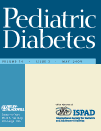Good glycemic control remains crucial in prevention of late diabetic complications – the Linköping Diabetes Complications Study
Abstract
Background: Several intervention studies have convincingly demonstrated the importance of good glycemic control to avoid long-term diabetic complications, but the importance of other risk factors remains controversial. We previously reported a markedly reduced incidence of severe retinopathy and nephropathy during the past decades in an unselected population of type 1 diabetes mellitus diagnosed in childhood. The aim of the present study was to analyze possible risk factors, which could explain the improved prognosis.
Methods: In this longitudinal population-based cohort study, we followed all 269 patients in whom type 1 diabetes mellitus was diagnosed in childhood 1961–1985 in a well-defined geographical area in Sweden. The patients were followed until the end of 1990s. Multivariable regression models were used to analyze the importance of hemoglobin A1c (HbA1c), diabetes duration, blood pressure, cardiovascular risk factors and persisting C-peptide secretion for the development of diabetic retinopathy and nephropathy.
Results: Beside longer duration and higher HbA1c, blood pressure and lipid values were higher and cardiovascular disease and smoking were more common in patients with severe complications. However, multivariable analysis abolished these associations. Diabetes duration and long-term HbA1c were the only significant independent risk factors for both retinopathy and nephropathy. The risk of overt nephropathy increased substantially when HbA1c was above 9.6% [Diabetes Control and Complications Trial (DCCT) corrected value], while the risk of severe retinopathy increased already when HbA1c exceeded 8.6%.
Conclusion: In this unselected population, glycemic control was the only significant risk factor for the development of long-term complications.




